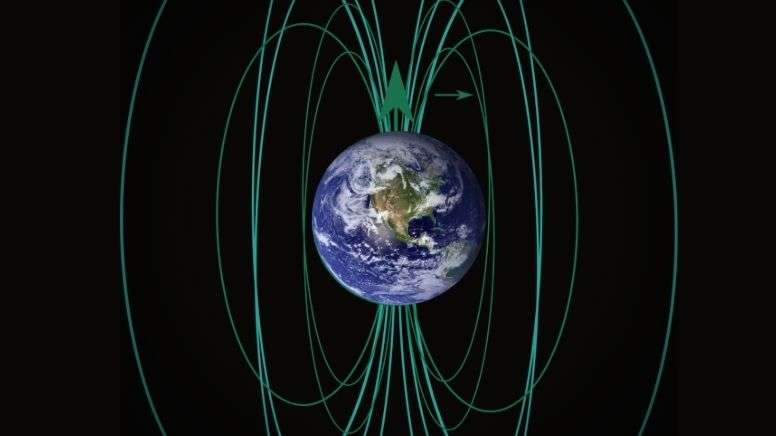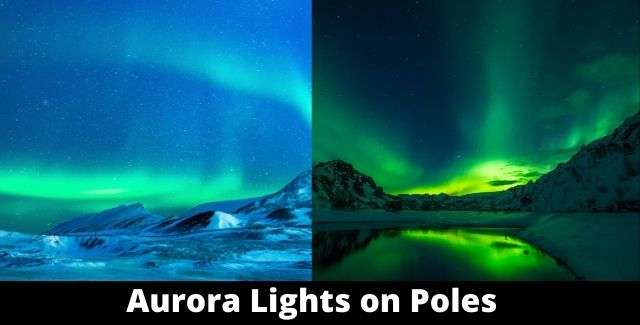
What is the Earth Magnetic Field?
It is a natural magnetic field that surrounds the Earth, comes from the earth core and goes to space of more than 10,000 kilometers—generated by solidification of Earth’s core (liquid core of iron and nickel).
The magnetic field is similar to the field around a bar magnet and is approximately a dipole, meaning that it has a north and south pole. The Earth’s magnetic field helps to protect the planet from harmful solar radiation and charged particles that are constantly bombarding the Earth from the sun.
It plays a role in navigation for birds and other animals, and also used in navigation for ships and airplanes.
What are the characteristics of Earth’s Magnetic Field?
The Earth’s magnetic field extends into space, forming a protective “bubble” called the magnetosphere, which protects Earth from solar flares and other harmful radiation.
Below are the 3 characteristics of Earth’s Magnetic Field:
1. Shape
Earth’s Magnetic Field roughly takes the shape of a teardrop with a long tail facing away from the Sun, similar to a bar magnet with elongated dipole, which has two poles, a north and a south magnetic pole.
However, the field is not perfectly symmetric and has more complex features due to improper distributions of molten metals like iron and nickel in the Earth’s core and the pressure of the solar wind such as magnetic field lines that curve and twist.
The shape of the magnetic field is constantly changing, with the field weakening and strengthening in different areas over time.
2. Strength
The motion of molten iron in the Earth’s core creates the powerful magnetic field by generating electric currents. The Earth’s core, made mostly of iron and nickel, has a solid inner core and a liquid outer core that flows to form the electric currents that generate the magnetic field.
Heat from the inner core drives the intensity of convection currents in the outer core, which also influences the strength of the magnetic field. Furthermore, the rotation of the Earth influences the intensity of the magnetic field by amplifying the electric currents that create it.
The intensity of the Earth’s magnetic field changes over time due to various factors such as variations in the Earth’s rotation and solar activity, which causes its overall strength to weaken and strengthen in different regions.
The motion of molten iron in the Earth’s core generates electric currents, which produce the powerful magnetic field. The intensity of the convection currents in the outer core, as well as the rotation of the Earth, determine the strength of the magnetic field.
Does the Earth’s magnetic field vary at different locations?
Yes, since it is not uniform, and when you move it, its distance from the earth’s core changes, causing the magnetic field to fluctuate.
Strongest and Weakest Locations
The flow of molten iron in the Earth’s core creates the strongest magnetic fields near the poles and weakest at the equator due to the concentration of lines of force at the poles.
Furthermore, because the Earth’s magnetic field is a global field rather than a point field, it is stronger at the poles and weaker at the equator.
What generates Earth’s Magnetic Field?
The molten iron and nickel in the outer core, located about 2,900 kilometers beneath the surface, generates electric currents through movement, creating the Earth’s magnetic field, called geodynamo.
Molten iron in the outer core movement powers the geodynamo, as it transfers heat from the Earth’s interior outwards and also creates convection currents, similar to how currents form in a pot of water when heated on a stove. These convection currents cause the molten iron to spin and flow in different directions, resulting in the generation of electric currents that produce the Earth’s magnetic field.
Propeller for continuous spinning
The Earth’s core is continuously spinning due to the internal energy source of heat. The decay of radioactive elements like uranium, thorium, and potassium found in the Earth’s mantle generates this heat. The heat from the decaying radioactive elements causes the liquid iron in the outer core to convect and creates a circulating motion that drives the rotation of the Earth’s core, similar to a pot of water on a stove.
Additionally, “primordial heat” is remaining over from the Earth’s formation, a process that generates heat in the core, also drives the convection in the core and contributes to the rotation of the Earth’s core. The combined heat from radioactive decay and primordial heat causes the convection in the outer core, which drives the rotation of the Earth’s core and generates the Earth’s magnetic field via the geodynamo process.
Who uses Earth Magnetic Field?
The Earth’s magnetic field greatly impacts the navigation of birds, animals, ships, and airplanes.
1. Birds and Animals
The Earth’s magnetic field plays a crucial role in the navigation of birds, animals, ships, and airplanes. Birds and animals, such as sea turtles and salmon, use this magnetic field to orient themselves during migration. They possess a protein called cryptochrome in their eyes that allows them to sense the magnetic field and navigate to their destination.
The Goethe-Institut in Germany is researching how birds use information gathered by their beak and eyes to create a navigational map. Cows and wild deer tend to align their bodies north-south while relaxing, but not when the animals are under high voltage power lines, leading researchers to believe magnetism is responsible.
Scientists believe that birds utilize a combination of magnetite in their beak and sensors in their eyes to navigate over vast areas lacking distinctive landmarks, such as the open ocean. Researchers discovered deposits of magnetite in human bones in the nose, leading to speculation that humans might use the Earth’s magnetic field to orient themselves, scientists still have not proved it yet.
Navigators consider the Earth’s magnetic field more reliable than other navigational cues like currents and tides, as it remains relatively stable. The mechanism sharks use to sense the magnetic field is still unknown, though a study from 2017 suggests that their magnetic receptors are located in their noses.
2. Humans
Humans use compasses by leveraging the Earth’s magnetic field to align a small magnetized needle with the Earth’s North and South poles.
3. Ships and Boats
Navigating using the Earth’s magnetic field is a common practice for ships and boats. Navigators widely use a compass, which uses a magnetized needle to point towards magnetic north, as a navigation tool on vessels. It enables the crew to establish their direction and reach their intended destination.
4. Airplanes
Airplanes use the Earth’s magnetic field for navigation as well. Along with compasses, they use additional aids to navigate and fly safely, such as the magnetic heading indication, which gives the pilot information on the aircraft’s magnetic heading, and the magnetic variation indicator, which indicates the difference between magnetic north and true north.
What does Earth’s Magnetic Field do?
#1 Protect us From Sun and Cosmic Rays
The Earth’s Magnetic Field protects earth from Sun radiation, Solar Wind, Solar Flares, and other harmful Cosmic Rays coming from deep space.
The Earth’s magnetic field plays a crucial role in protecting us from the solar winds (charged particles that the Sun continually throws at us).
The magnetic field extends from the planet’s core to the surface, creating an invisible barrier known as the magnetosphere. This shield deflects harmful ultraviolet rays, keeping us safe.
Why Earth needs to be protected from Solar wind, Flares, Radiation?
Because these occurrences have the potential to destroy the world and its inhabitants. Solar wind may deplete planets’ upper atmospheres, including Earth’s, but solar flares can interrupt communications systems and harm satellites in orbit. In addition, solar radiation may harm living creatures by damaging DNA and increasing the risk of cancer.
How does Earth protect us from Solar Wind, Solar Flares, Sun Radiation, and other harmful cosmic rays?
The Earth’s magnetic field is crucial in safeguarding the planet from these negative impacts. The planet’s magnetic field works as a shield, diverting solar wind and radiation away from it.
When solar wind and radiation hit the magnetosphere, which has the highest magnetic field, it deflects them away, and they cannot reach the planet’s surface. This bubble also aids in the trapping of particles released by the sun, keeping them from entering the Earth’s atmosphere.
In summary, the Earth’s magnetic field acts as a shield for the planet, diverting solar wind, flares, and radiation away from the Earth and trapping any particles that may enter the atmosphere. It also reduces the impact of these phenomena on human technology and protects living organisms from radiation.
#2 Change direction (Reversal)
The Earth’s magnetic field is not a static field, but rather it is constantly changing in both strength and direction.
Magnetic reversals is one way the magnetic field can change direction. A magnetic reversal occurs when the Earth’s magnetic field flips, with the north magnetic pole becoming the south pole and vice versa. This flipping can occur over a period of thousands or even millions of years. The Earth’s magnetic field has undergone several reversals throughout its history, with the most recent one occurring around 780,000 years ago.
Geomagnetic excursions is another way the Earth’s magnetic field can change direction. A geomagnetic excursion is a temporary change in the Earth’s magnetic field, where the field can change direction and intensity over a period of several thousand years. Scientists think that Earth’s Core cause these excursions, such as the movement of molten iron.
In summary, the Earth’s magnetic field can change direction due to a variety of factors, including magnetic reversals, geomagnetic excursions, and solar activity. These changes can occur over a period of thousands or even millions of years and can have a significant impact on the Earth and the organisms that live on it.
#3 Cause Northern Lights

When the solar wind collides with the magnetosphere, it can create an aurora. This phenomenon occurs when the charged particles from the sun interact with gasses in the magnetosphere, causing them to emit light.
The aurora appears as an elongated, comet-shaped structure, with a tail pointing away from the sun. The Northern Lights, or Aurora Borealis, typically happen at night in the polar regions, but can occasionally be seen in other areas of the world. The Southern Lights, or Aurora Australis, are their counterparts in the southern hemisphere.
Without a magnetic field, the Earth would not have this protective barrier and the solar wind would directly hit the Earth’s atmosphere, potentially causing damage to the planet’s surface and to living organisms. Therefore, auroras would not occur without the Earth’s magnetic field.
How is the measurement of Earth’s Magnetic Field done?
We use a magnetometer for measuring the strength and direction of the Earth’s Magnetic Field. The magnetometer can take on several shapes, but all measure the magnetic field’s strength and direction.
The proton precession magnetometer, for example, measures the magnetic field using the magnetic characteristics of protons. First, one aligns protons with the magnetic field by putting a sample of hydrogen in a magnetic field, followed by sending a radio frequency pulse to the hydrogen, causing the protons to rotate around the magnetic field. The frequency of this rotation is proportional to the strength of the magnetic field and can be used to calculate the field strength.
The fluxgate magnetometer is another type of magnetometer that uses magnetic flux to detect the strength and direction of a magnetic field. When you apply magnetic field to the tiny wires coiled around a magnetic core, it creates a current and a secondary magnetic field. The strength of the secondary magnetic field is exactly proportional to the strength of the applied magnetic field, and we can use this to calculate the magnetic field.
Another type of equipment used to measure the Earth’s magnetic field is an Overhauser magnetometer, which employs the Nuclear Magnetic Resonance principle (NMR). You just have to send a radio frequency pulse to a sample of hydrogen or another appropriate substance after aligning the protons or nuclei inside it by using a magnetic field. This causes the protons or nuclei to absorb and re-emit energy, and we can use the frequency of re-emitted energy for finding the intensity of the magnetic field.
Industries such as geophysics, mineral exploration, and navigation use magnetometers and often pair them with other devices like GPS and accelerometers to obtain more accurate and comprehensive measurements of the Earth’s magnetic field.
What variations can we see in the magnetic field?
Various national and international observatories and research institutes continuously monitor all the variations that occurred using different types of magnetometer and other related instruments.
Understanding these variations can help us to understand the Earth’s magnetic field, the Earth’s interior, and the impact of solar activity on the Earth’s environment.
We can observe several variations of the Earth’s magnetic field, major variations include:
1. Diurnal variation
The interaction of the solar wind with the Earth’s magnetosphere induces this daily change in the magnetic field.
2. Seasonal variation
Variations in solar activity generate this shift in the magnetic field, which can impact the Earth’s magnetosphere.
3. Latitudinal variation
The geomagnetic field of the Earth induces this magnetic field fluctuation, which is strongest near the poles and weakest near the equator.
4. Longitudinal variation
Earth’s rotation generates this magnetic field variation, causing the magnetic field to change depending on one’s location on the Earth’s surface.
5. Secular variation
Changes in the Earth’s core induce this gradual shift in the magnetic field.
6. Magnetic storm
A solar flare or a coronal mass ejection causes a transient disturbance in the Earth’s magnetic field. This can cause the magnetic field to quickly vary, affecting satellites and power systems.
7. Magnetic Anomaly
Changes in the Earth’s crust, such as the existence of iron-rich minerals, induce these changes in the Earth’s magnetic field.
What is the value of Earth ‘s Magnetic Field?
The intensity of the Earth’s magnetic field ranges from approximately 25,000 to 65,000 nT .
In Tesla
The value of Earth’s magnetic field in unit “tesla” is 0.00005 tesla.
In Gauss
The value of Earth’s Magnetic Field in unit “gauss” is .25 to .65 gauss.
FAQs
What causes Earth’s Magnetic Field?
Let’s take a look at our Earth.
When cutting a cross-section at the inner half, you get a section “Core”.
Our Earth’s Core is of the size of Mars and is actually predominantly liquid metal however it’s pressure is so high that at its innermost thirds it is solidified which takes the form of solid composed of iron with some nickel and some other stuff.
When the liquid metal in the outer core flows, it generates electric currents. Due to the rotation of Earth at its own axis, the electric currents from magnetic fields around the earth.
How does Earth’s Magnetic Field Save us from Harmful Radiations of the Sun?
Earth’s own magnetic field (magnetosphere) deflects nearly all the charged volatile solar winds and cosmic radiation, however, Van Allen Radiation Belt traps some of them. Therefore, it works as the shield against solar wind, flares and radiation.
How does solar wind affect earth?
When the solar wind flows toward earth, it carries harmful radiation which hits the earth’s magnetic field. That hit causes disruption and shock to the magnetic field which results in turbulence.
Due to the turbulence, solar wind enters our atmosphere which heats more and expands more.
It causes problems with machinery and reduces the lifetime of earth-orbiting satellites lower than 1,000 km (620 miles).
What happens when earth’s magnetic field interacts with the solar wind?
The Earth’s magnetic field deflects charged particles (harmful solar radiation) and creates an extended cavity in the solar wind.
They emit shock waves in the shape of a bow around the planet during their encounter.
Solar wind ions collides with oxygen and nitrogen atoms in the earth’s atmosphere, energizes themand then attempt to arrive at a calm state.
So, when they are calm and comfortable, they release energy, which generates multicolored brilliant lights like the Aurora at both poles.
Where do Aurora occur in the atmosphere?
Observers frequently observe aurora in regions near both poles, i.e. north and south.
The majority of Auroras occur between 97 and 1,000 kilometers (60 and 620 miles) above the Earth’s surface.
They are most common in the thermosphere, a layer of the earth’s atmosphere located between the Mesosphere and the Exosphere.











